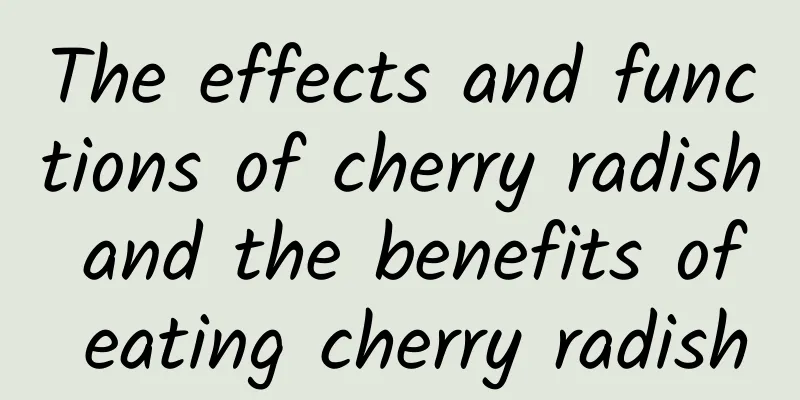What are the benefits of eating persimmons? What are the disadvantages of eating persimmons?

|
Persimmons are flat and round in shape. Different varieties vary in color from light orange to dark orange. They are 2 to 10 cm in size and weigh 100 to 350 grams. Persimmons are tall deciduous trees of the Ebenaceae family. They are native to China and are widely distributed in various places. They have been cultivated for more than a thousand years. What are the advantages and disadvantages of eating persimmons? Benefits of eating persimmonsPersimmons have high nutritional value Mature persimmons contain 15% sugar, 1.36% protein, 0.57% fat, as well as crude fiber, carotene, calcium, phosphorus, iron and other elements and multiple vitamins, especially vitamin C, which is 1-2 times higher than that of ordinary fruits. Persimmons are nutritious, bright in color, soft and juicy, sweet and delicious, and are loved by people of all ages. According to measurements, every 100 grams of persimmons contains more than 15 grams of carbohydrates, 28 grams of sugar, 1.36 grams of protein, 0.2 grams of fat, 19 milligrams of phosphorus, 8 milligrams of iron, 10 milligrams of calcium, 16 milligrams of vitamin C, and a variety of nutrients such as carotene. It can be eaten raw, processed into persimmon cakes and persimmon cakes, and can be used to make wine and vinegar. Persimmons are not only nutritious, but also have high medicinal value. Raw persimmons can clear away heat and detoxify, and are a good medicine for lowering blood pressure and stopping bleeding. They have good therapeutic effects on the treatment of hypertension, hemorrhoid bleeding, and constipation. In addition, persimmon burdock and persimmon leaves are very valuable medicinal materials. Although persimmons are good, you should not eat too much, nor eat them on an empty stomach, and avoid eating them with acidic foods. Because persimmons contain a large amount of tannic acid, gum and pectin, tannic acid will precipitate and condense into blocks in the stomach under the action of gastric acid, forming "gastric persimmon stones". Gastric persimmon stones will become stronger and harder to crush, causing congestion, edema, erosion and ulcers of the gastric mucosa. In severe cases, it can cause gastric perforation. In addition, be careful not to eat unripe persimmons, because the tannic acid content in unripe persimmons is as high as about 25%, while mature persimmons only contain 1%. In addition to not eating acidic foods immediately after eating persimmons, you should also avoid taking certain medicines at the same time. Medicinal value of persimmon There are thousands of varieties of persimmons in the world, and they are divided into two categories: astringent persimmons and sweet persimmons, depending on whether they can naturally remove the astringency before ripening on the tree. Among them, astringent persimmons (most of the persimmons on the market in my country belong to this category) must be artificially removed after picking before they can be eaten. The material basis for the astringency of astringent persimmons is tannic acid (also known as tannic acid). Persimmons contain a lot of carbohydrates, with 10.8 grams per 100 grams of persimmons, mainly sucrose, glucose and fructose, which is why everyone feels that persimmons are very sweet. There are not many other nutrients in persimmons, only a small amount of fat, protein, calcium, phosphorus, iron and vitamin C. In addition, persimmons are rich in pectin, which is a water-soluble dietary fiber that has a good laxative effect on the intestines. It has a good effect on correcting constipation and maintaining the growth of normal intestinal flora. According to traditional Chinese medicine, persimmons are sweet, astringent, and cold in nature. They have the functions of clearing away heat and dryness, moistening the lungs and resolving phlegm, softening hard masses, quenching thirst and promoting the production of body fluids, strengthening the spleen, treating dysentery, and stopping bleeding. They can relieve constipation, hemorrhoid pain or bleeding, dry cough, sore throat, and high blood pressure. Therefore, persimmons are a natural health food for patients with chronic bronchitis, hypertension, arteriosclerosis, and internal and external hemorrhoids. If persimmon leaves are decocted or brewed with water as tea, they can also promote metabolism, lower blood pressure, increase coronary blood flow, and relieve cough and resolve phlegm. Disadvantages of eating persimmons1. Persimmons contain tannins, gums, pectin and other ingredients. If consumed in excess, they will combine with protein under the action of gastric acid to form acid proteins that are larger in molecules and not easily soluble in water. Then the acid proteins, gums, persimmon peels, persimmon cores and plant fibers will stick together to form persimmon stones. 2. People with diabetes should not eat persimmons because they contain 10.8% sugars, most of which are simple disaccharides and monosaccharides (sucrose, fructose, glucose). Therefore, they are easily absorbed after eating and increase blood sugar. For people with diabetes, especially those with poor blood sugar control, it is even more harmful. 3. Persimmons are high in sugar and pectin. After eating persimmons, some of them will remain in the mouth, especially in the gaps between teeth. Coupled with the weakly acidic tannic acid, it is easy to erode the teeth and form caries. Therefore, it is advisable to drink a few sips of water or rinse your mouth in time after eating persimmons. 4. There are some persimmons on the market that look tempting and red, but they don't taste sweet at all. They are probably ripened with hormones. Because it is difficult to distinguish them from the outside, it is recommended that you buy one to taste before deciding whether to buy more. |
<<: Why can't you eat persimmons on an empty stomach?
>>: Nutritional value and taboos of eating persimmons
Recommend
How to grow Vietnamese melons and how to eat Vietnamese melons
Vietnamese milk melon is called the magical fruit...
What are the nutritional values of broad beans
When I am at home, I often go to the vegetable ma...
How to plant water spinach
Water spinach is a very common vegetable. Do you ...
How is Sunshine Liston Travel Agency? Reviews and website information of Sunshine Liston Travel Agency
What is Sunny Liston Tours? Sunny Liston Tours is ...
What should we pay attention to when eating grapes?
Grapes are a common fruit that is delicious and n...
What is Origin Energy? Origin Energy Reviews and Website Information
What is the website of Origin Energy? Origin Energ...
What is the Singapore Ministry of Transport like? Singapore Ministry of Transport reviews and website information
What is the website of the Ministry of Transport o...
How to make fried black fungus and shredded pork
Fungus is a very common and nutritious vegetable....
How is Hendrix College? Hendrix College reviews and website information
What is Hendrix College? Hendrix College is a well...
Effects and functions of prickly lettuce
What is thorny vegetable? It is a perennial herb....
How to eat brown rice How to eat brown rice
Brown rice is a common type of whole grain. It is...
How to peel water chestnuts (water chestnuts)? The effects and functions of water chestnuts (water chestnuts)
Water chestnuts are also called water chestnuts, ...
Cultivation methods and precautions of Yushu
In today's society, life is very stressful. M...
The efficacy and function of Osmanthus fragrans
Osmanthus fragrans is actually the tender petiole...
The efficacy and nutritional value of carrot and lean meat porridge
Many people like to eat carrot and lean meat porr...









